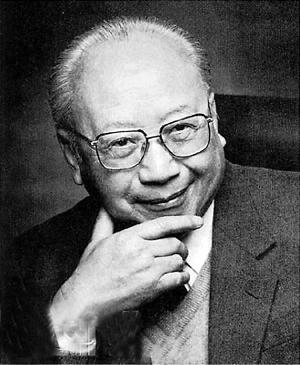Renowned Chinese scientist, academician of the Chinese Academy of Sciences, QIAN Weichang died in Shanghai Friday morning.
 |
| QIAN Weichang, Member of the Chinese Academy of Sciences |
QIAN Weichang (also knows as Chien Wei-zang) is a well-known scientist in applied mathematics, mechanics and physics. He was born on Oct.9, 1913 at Wuxi, Jiangsu province, and graduated from Physics Department of National Tsinghua University, Beijing, with B.Sc. in 1935. Studied as post-graduate student in Applied Mathematics Department of the University of Toronto, Canada, he obtained M.A. degree in 1941, and Ph.D. in 1942.
He worked as research engineer in Jet Propulsion Laboratory, California Institute of Technology, Pasadena, California in 1942-1946. He was professor, dean and vice president in Tsinghua University in 1946-1982, president of Shanghai University of Technology in 1982-1994, president of Shanghai University in 1994-now. He was also the vice director of Institute of Mechanics(1955-1958), director of Institute of Automation (1956-1958) and Shanghai Institute of Applied Mathematics and Mechanics(1984-now), member of Academia Sinica (1954-now) and member of Polish Academy of Science(1955-now).
Prof. QIAN s scientific works in his last sixty years (1935-1997) covered large number of important areas in applied mathematics. Outstanding contributions are made on the intrinsic theory of plates and shells, large deflection theory of plates and shells, and their perturbation method and singular perturbation method of solutions, generalized variational principles, analytical solution of ring-shell, Chinese computer codes, etc.
First paper on the Intrinsic Theory of Shells and Plates was published in von Karman Anniversary volume (1940) by J.L.Synge (F.R.S) and Chien (QIAN), and a series of paper published by QIAN on the same problem attracted wide-interest during 1940-1970, especially important are the nonlinear equations for the treatment of nonlinear stability problems of shallow shells. In 1960-1970, these equations are named as Chiens (QIANs) equation for nonlinear stability of shallow shells.
In 1948, a new parametric perturbation theory was suggested to solve the von Karman large deflection problem. This method can be used to solve many other difficult nonlinear problems. The method is named as Chiens (QIANs) method in soviet and other literature. His works on generalized variational principle (1970-1990) are very useful in simplify the finite-element calculations.
QIAN successfully suggested the using of the method of Lagrange multiplier for eliminating the constraint conditions of all kinds of variational problems, and thus established a new variational functional, finally changing the max.-min. ordinary variational problems with constraint conditions into stationary generalized variational problems with no constraint conditions or less conditions.
This method can be used to solve many variational problems in solid mechanics, fluid mechanics, heat conduction, electromagnetic field problems, etc.
From 1990, QIAN has developed a new field of non-Kirchhoff-Love theory of plates and shells. This work can be used for solving the thick plates and thick shells. This work is important for the design of high-pressure containers and heavy machinery.
Related News
Photos
More>>trade
market
finance
- Two Chinese Academicians Win Nation's Top Science Prize
- New Long-Tailed Pterosaurs Found in Western Liaoning, China
- Speeding up Electrons in Solar Cells
- IVPP Research Ranks among Discover Magazine's Top 100 Science Stories of 2010
- Advances of Cranial Morphology of Silurian Sarcopterygian Guiyu Oneiros





